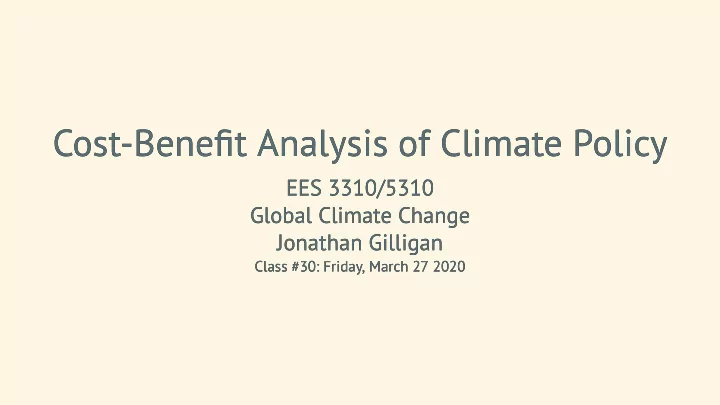

Cost-Bene�t Analysis of Climate Policy Cost-Bene�t Analysis of Climate Policy EES 3310/5310 EES 3310/5310 Global Climate Change Global Climate Change Jonathan Gilligan Jonathan Gilligan Class #30: Class #30: Friday, March 27 Friday, March 27 2020 2020 /
Climate Casino Climate Casino /
Climate Casino Climate Casino Optimal Policy: Optimal Policy: Inef�cient: Inef�cient: 100% ef�cient 100% ef�cient Limited Participation Limited Participation /
Climate Casino Climate Casino Optimal Policy: Optimal Policy: Limited Participation Limited Participation 100% ef�cient 100% ef�cient with Discounting with Discounting /
Climate Casino Climate Casino Limited Participation Limited Participation Limited Participation with Discounting Limited Participation with Discounting with Discounting with Discounting and Tipping Points and Tipping Points /
Summary of Principles: Summary of Principles: Higher damages with higher temperatures Higher costs of emissions abatement for lower temperature targets Higher costs when participation is limited and abatement is inefficient Lower damages when you account for discounting Tipping points can change everything /
Microeconomics Microeconomics and and Emissions Reduction Emissions Reduction /
Technical Microeconomics Technical Microeconomics Marginal costs and benefits: iPhones: Billions of dollars to build the first iPhone Less than $500 to build the millionth iPhone Production possibilities: Economies of scale Marginal costs fall as volume increases Diminishing returns: Marginal costs rise as volume increases Gross costs: Sum of marginal costs for all units produced /
Using Graphs to Avoid Math Using Graphs to Avoid Math Costs vs. benefits for increasing CO 2 abatement MC = marginal cost to society of emissions (pollution) MB = marginal benefit of emissions (economic output) When MC > MB, it’s worth cutting emissions. When MC < MB, cutting emissions costs more than it’s worth. When MC = MB: equilibrium, optimal amount of emissions. /
Slope of MB Slope of MB Costs vs. Benefits of Emissions Why does MB slope down? Optimal emissions: When energy is plentiful, diminishing returns on using more Implications for cutting emissions: Marginal benefit of emissions = marginal cost of cutting emissions. Do cheap things first (small marginal cost to reduce emissions) When you run out of cheap things, turn to expensive ones /
Slope of MC Slope of MC Costs vs. Benefits of Emissions Why does MC slope up? Greater emissions mean more warming Greater warming = greater damage: Going from 3°C to 4°C is much worse than going from 2°C to 3°C Benefit of reducing warming from 4°C to 3°C is worth more than reducing it from 3°C to 2°C /
Marginal vs. Gross Bene�t Marginal vs. Gross Bene�t E = emissions (abatement) B = marginal benefit Blue area = total gross benefit to society from emissions /
Marginal vs. Gross Cost Marginal vs. Gross Cost E = emissions (abatement) C = marginal cost Blue area = total gross cost to society from emissions /
Putting it Together Putting it Together Marginal benefit at E = B Marginal cost at E = C Marginal net benefit at E = (B - C) /
Putting it Together Putting it Together Gross benefit at E = area under MB (light + dark blue) Gross cost at E = area under MC (dark blue) Gross net benefit at E = gross benefit - gross cost Light-blue trapezoid /
Total Net Bene�t Total Net Bene�t /
Optimizing Emissions Optimizing Emissions /
Optimum Emissions Optimum Emissions Optimum emissions = E* Actual emissions = E Little triangle on right: Costs > Benefits (net loss) EPA issues only enough permits to allow emissions of E* Free trading in permits cuts emissions to E* at lowest possible cost Total net benefits to society are maximized. /
Optimum Emissions Optimum Emissions Optimum emissions = E* EPA issues only enough permits to allow emissions of E* Free trading in permits cuts emissions to E* at lowest possible cost Total net benefits to society are maximized. /
Deadweight Losses Deadweight Losses Optimum: E* EPA cuts emissions too far, to E’ Deadweight loss = empty triangle (difference between actual net benefit and optimum net benefit). /
Deadweight Losses Deadweight Losses Optimum: E* EPA cuts emissions too far, to E’ Deadweight loss = blue triangle (difference between actual net benefit and optimum net benefit). /
Recommend
More recommend